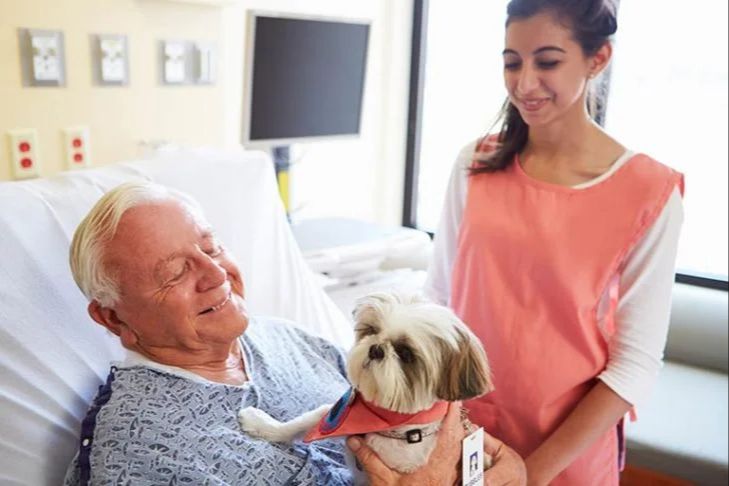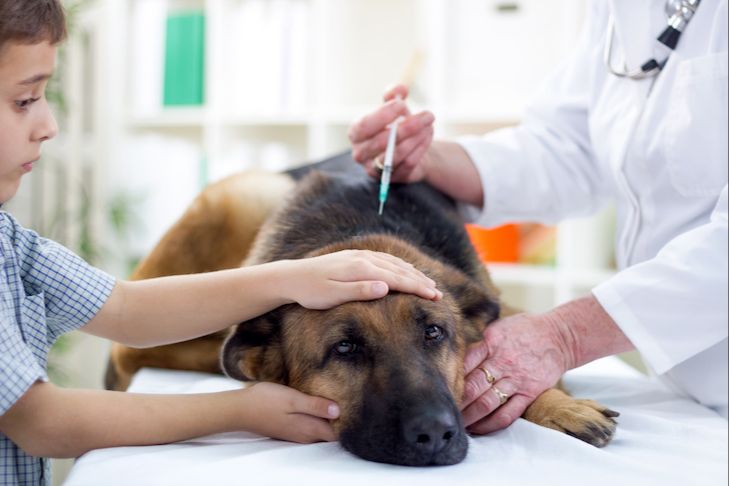Introduction
A dog’s period, also known as estrus or heat, is a normal biological process that healthy intact female dogs experience. During this time, a dog’s hormones fluctuate, their reproductive tract matures, and their body prepares for pregnancy. Knowing what to expect during a dog’s heat cycle and how to care for them is important for any dog owner.
A dog’s period usually occurs every 6-8 months and lasts around 2-3 weeks. The frequency and length can vary between breeds and individual dogs. There are four stages to the canine heat cycle: proestrus, estrus, diestrus, and anestrus. During proestrus and estrus, estrogen levels peak as eggs mature and the uterine lining thickens in preparation for pregnancy. Understanding the changes a dog undergoes during this time allows owners to properly care for their health and wellbeing.
Physical Symptoms
Female dogs will show several physical symptoms when they are in heat. Some of the most common physical changes during a dog’s heat cycle include:
Changes in vulva appearance: The vulva and vaginal opening will swell and take on a pink/red color. This is due to increased blood flow to the area. The vulva may also secrete a light blood-tinged discharge during the heat cycle.
Abdominal cramping/discomfort: Some female dogs experience mild abdominal discomfort or cramping during their heat, similar to menstrual cramps in humans. This is from contractions in the uterus and swelling in the genital area.

Changes in appetite: Appetite changes are common during a dog’s heat cycle. Some dogs will eat more than usual due to hormonal fluctuations. Others may eat less if they are feeling abdominal discomfort.
Behavioral Changes
During their heat cycle, dogs may exhibit different behaviors than usual. Two of the most common behavioral changes are increased nesting behaviors and decreased activity levels. Dogs become more reclusive during this time.
When nesting, dogs look for cozy and secluded places where they want to rest. You may notice your dog spending more time in their bed or crate, or trying to hide under furniture or blankets around your home. Nesting helps satisfy a dog’s instinct to create a safe den during their vulnerable heat cycle.
Along with nesting more, dogs tend to become less active when in heat. Their regular playfulness and energy levels drop due to shifts in hormone levels. Leashed walks may become less adventurous. Your dog may prefer lounging around to playing fetch or going for long runs.
In addition to nesting and reduced activity, dogs often become more reclusive when menstruating. They seek quiet time alone, away from bustling household activities. Your extroverted dog may start ignoring guests or avoiding interactions they’d normally relish. This introverted behavior serves their needs during this time.
Do Dogs Experience Discomfort?

There is some research indicating that female dogs may experience mild to moderate discomfort during their heat cycles. The shifting hormone levels associated with the estrous cycle can cause uterine cramping and physical symptoms like swelling and discharge. This may lead to general soreness or sensitivity in the abdominal and genital region.
Additionally, the female dog’s behavior changes during this time, which could suggest some psychological or emotional distress. The urge to find a mate and nest-building behavior may cause restlessness. Appetite changes are also common.
While the pain levels are not extreme for most dogs, some things can help minimize discomfort during their heat:
- Providing a soft bed or pillows
- Giving access to plenty of water
- Adjusting exercise to the dog’s comfort level
- Giving soothing massages
- Keeping the genital area clean
With some extra care and TLC from pet parents, female dogs can get through their cycles with minimal pain or unease.

Do Dogs Cry More During Their Period?
While there’s no conclusive scientific evidence that dogs cry more during their heat cycle, many owners do report anecdotally that their dogs seem more emotional and prone to tear production when in heat.
This may be due to the hormonal fluctuations and discomfort associated with estrus. The rise in estrogen that occurs right before the fertile period leads to swelling of the vulva and bloody discharge. This understandably causes irritation and pain, which can make dogs more sensitive and prone to crying.
In addition to physical discomfort, the heat cycle seems to affect dogs emotionally too. Female dogs may become more attention-seeking, needy, or anxious during this time. They are more easily frustrated or upset. Things that normally wouldn’t bother them suddenly make them whine or yelp.
So while there aren’t hard statistics, the weight of real-world experience indicates dogs often do appear more likely to cry during their heat. This is likely due both to physical and emotional factors influenced by their hormonal state.
Why Dogs May Appear More Emotional
During their heat cycle, dogs undergo significant hormonal changes as their bodies prepare for pregnancy and motherhood. These hormonal fluctuations can lead to changes in mood and behavior that may make some dogs seem more emotional or sensitive than usual.
In addition to hormonal changes, dogs in heat often experience physical discomfort like cramping, bloating, and vaginal swelling. This physical discomfort can make dogs feel irritable, restless, and vocalize more than normal.
Dogs also don’t fully understand what’s happening to their bodies during this time. The changes in their behavior and personality during their heat cycle can be confusing or stress-inducing for some dogs. This stress and confusion may lead to increased whining, clinginess, anxiety, or other behaviors that their owners perceive as emotional.
So while dogs may not experience emotions identically to humans, the combination of hormonal fluctuations, physical discomfort, and confusion during heat can understandably make some dogs appear more sensitive or emotionally needy than usual. Being patient, providing comfort, and keeping routines consistent can help ease a dog’s stress until their cycle passes.
Managing a Dog on Their Period
There are some helpful ways to support your dog’s comfort and well-being during her heat cycle:
- Provide extra affection and gentle petting to help soothe your dog if she seems uncomfortable or needy.
- You may let your dog rest in your bedroom at night if she prefers to sleep close to you.
- Use puppy pads if your dog will be home alone for long periods to prevent spotting.
- Limit strenuous exercise that could cause discomfort.
- Go on shorter, gentler walks rather than long runs or hikes.
- Reduce playtime with other household pets that may bother her.
- Confine your dog when you are away to protect furniture and prevent escape.
- Keep intact male dogs away to avoid pregnancy.
- Groom your dog frequently to remove shed hair and keep her clean.
Making small adjustments can go a long way in keeping your dog relaxed and stress-free while she goes through her heat cycle. Still make sure she gets adequate daily activity and enrichment during this time. Meet her needs for increased affection if she desires extra comfort and care.
When to See the Vet
While a dog’s heat cycle is a normal occurrence, there are times when you may want to seek veterinary attention. Here are some signs that suggest your dog needs medical care:

If symptoms seem extreme: Most dogs experience mild symptoms during their heat cycle. However, if your dog is displaying severe lethargy, loss of appetite, vomiting, or other concerning symptoms, they may have a medical issue unrelated to their cycle that requires veterinary care.
If heat cycles stop: Adult dogs usually go into heat every 6-8 months. If your dog hasn’t had a heat cycle in over a year, bring them to the vet for an examination. Your vet can run tests to check for underlying medical conditions that may be preventing normal estrus cycles.
Seeing the vet promptly when these issues arise can help diagnose and treat any problems early on. Don’t hesitate to call your vet if your dog’s heat cycle seems abnormal or their symptoms have you worried. It’s better to be safe than sorry when monitoring your dog’s health and wellbeing.
Other FAQs
Here are some other common questions about dogs and their periods:
Do dogs get mood swings on their period?
Some dogs may experience mood changes like increased irritability and restlessness during their heat cycles. The hormonal fluctuations can cause shifts in their behavior. However, keep in mind that every dog is different. Some dogs act no differently during their periods.
Should I walk my dog when she’s on her period?
Yes, you should continue walking and exercising your dog normally during her heat. The physical activity and change of scenery is healthy and can help distract her from any discomfort. Just be sure to keep her on a leash and avoid areas where she could come into contact with intact male dogs.
Conclusion
In summary, female dogs do experience a range of physical symptoms and behavioral changes when they are on their period, which can cause varying degrees of discomfort. While dogs do not menstruate and shed bloody uterine lining like humans do, their vulva will swell and they will bleed from their vagina for part of their 21-day cycle.
Some of the key symptoms during this time include swollen private parts, blood spotting, enlarged mammary glands, decreased appetite, increased thirst, restlessness, and mood changes. Dogs tend to pay more attention to their hindquarters when they are in heat. You may also notice more frequent urination. Each dog experiences these changes differently.
It’s important to monitor your dog closely during her heat cycle. Keep her away from male dogs, provide proper nutrition and hydration, give her a quiet space to rest, and watch for signs of illness. Contact your vet if symptoms persist longer than 1-2 weeks or seem abnormal for your dog. With the proper care and supervision, you can help keep your dog comfortable and safe while she goes through her normal biological cycle.